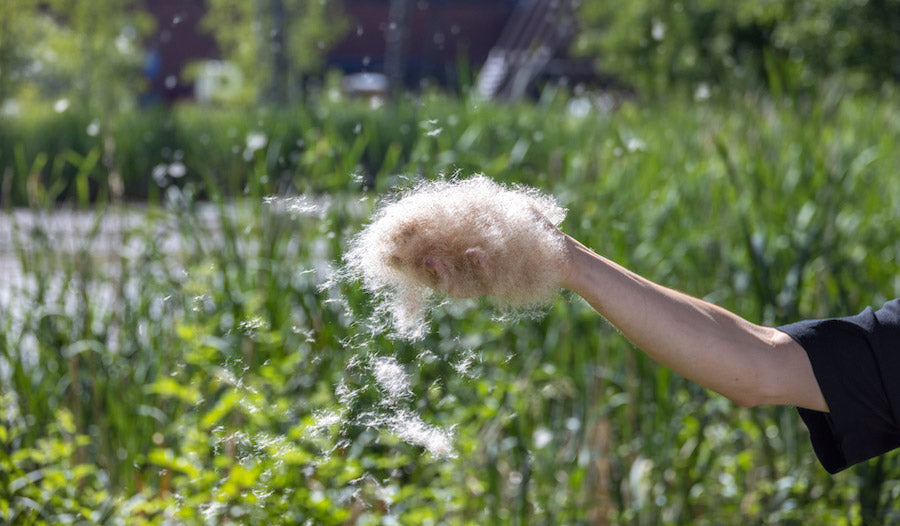
WARP SUN, WEFT SEED
Image: Typha fibres, from cattail plants, used for the ‘Fluff Stuff’ project. 2022. Aalto University. Courtesy of Dezeen.
“You can find textiles in road construction, in architecture or, for example, in medical applications,” says Maarit Salolainen, Professor of Textile Design at Aalto University, in Finland.
Her kind of ‘textile thinking’ informs the innovative curriculum at Aalto, where understanding the essence of textile techniques, processes, and practices, and grasping the basic alphabet of the textile field— fibres, materials, and structures —is only the beginning of the development of sustainable textile futures.
 Image: Courtesy of Aalto University
Image: Courtesy of Aalto University
Their Master’s Programme in Fashion, Clothing and Textile Design embeds opportunities for holistic thinking, creativity, and innovation through altoTEXTILES, a network linking all textile-material related activities within design, technology, and business across Aalto University, facilitating cross-disciplinary work, particularly in the context of sustainability and creativity. AaltoTEXTILES also generates new research projects by collaborating with companies, both nationally and internationally.
As part of the recent Dialogues 2022 event at New York Textile Month, Salolainen explained the fundamentals of their approach.
Inspiring students and researchers to experiment together, creating new uses for cellulose and other biomaterials, and exploring new perspectives on human-centred design, Aalto’s approach certainly seems to reap dividends.
In 2021, their Nordic network on smart light-conversion textiles showcased an industrially scalable, textile-integrated solar cell manufacturing process, developed and tested through Aalto’s Wearable Systems Lab, a ‘creative community that studies diverse aspects of fashion’.
Aalto’s Multifunctional Materials Design research group focuses on experimental studies of soft materials, as well as inorganic-organic hybrids. In 2022, students produced ‘Fluff Stuff’, a textile filling created from cattail plants, cultivated on rewetted Finnish peatlands. The result of a collaboration between an engineering student, Lucas Schuck, and a fashion design student, Tea Auramo, prototypes for both homeware and clothing were shown at the Helsinki Design Week. Each product is stuffed with plant fibres instead of traditional, carbon-intensive down filling. According to the Fluff Stuff team, cattail absorbs 66 percent less water than down, and dries twice as fast. ‘Typha fibres are naturally coated by a wax layer, making them highly hydrophobic’, they explain.
 Image: Prototype ‘Fluff stuff’ jacket, filled with typha fibres, from cattail plants. Courtesy of Aalto University and Dezeen.
Image: Prototype ‘Fluff stuff’ jacket, filled with typha fibres, from cattail plants. Courtesy of Aalto University and Dezeen.
For those of us unable to enjoy Aalto’s approach on campus, Salolainen has published Interwoven. Exploring Materials and Structures (Aalto-yliopiston taiteiden ja suunnittelun, 2022). The book encourages exploration into woven structures and their interplay with different materials, inspiring its readers to tell textural, tactile stories through textiles. It illustrates a new pedagogical method for woven textile design studies; from basic weave structures to multi-layered constructions and digital jacquard design, from experimenting and exploring to industrial manufacturing, and from conceptual to professionally coordinated fabric collections, Salolainen dissects woven structures, along with the fibres and yarns used to make them, giving exceptional insight into the breadth of her pedagogical approach.
Use the code interwoven20 for 20% off your copy, when ordered directly from Aalto.
 Image: Detail from Interwoven. Exploring Materials and Structures. Salolainen, M. (Aalto-yliopiston taiteiden ja suunnittelun, 2022)
Image: Detail from Interwoven. Exploring Materials and Structures. Salolainen, M. (Aalto-yliopiston taiteiden ja suunnittelun, 2022)
